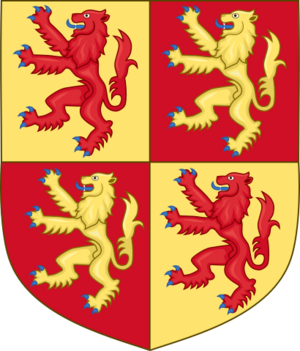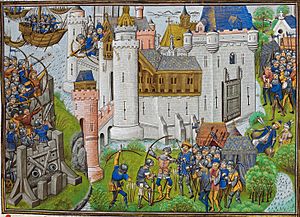Owain Lawgoch facts for kids

Owain Lawgoch (which means English: Owain of the Red Hand in Welsh, and French: Yvain de Galles in French) was a brave Welsh soldier. His full name was Owain ap Thomas ap Rhodri. He was born around c. 1330 and died in July 1378. Owain fought in many parts of Europe, like France, Switzerland, and parts of Italy. He led a group of soldiers, sometimes called a "Free Company," who fought for the French king against the English during the Hundred Years' War. Owain was also important because he was a descendant of Llywelyn the Great, a famous Welsh prince. Because of this, he believed he should be the true Prince of Gwynedd and of Wales.
Owain's Family History
After Llywelyn the Last, the last independent Prince of Wales, died in 1282, and his brother Dafydd ap Gruffudd was executed in 1283, Wales came under English rule. Llywelyn's daughter, Gwenllian ferch Llywelyn, was sent to live in a nunnery. Dafydd's sons were kept in Bristol Castle until they died.
Another of Llywelyn's brothers, Rhodri ap Gruffydd, gave up his claims in Wales. He lived most of his life in England and received money from the English king. Rhodri's son, Thomas, inherited lands in England.
Rhodri was happy to live as a country gentleman in England. His son, Thomas ap Rhodri, used the four lions symbol of Gwynedd on his seal, but he didn't try to get his Welsh inheritance back. Owain was Thomas's only son. He was born in Surrey, England, where his grandfather owned a large estate.
Owain Lawgoch joined the army of Philip IV of France. He spent most of his life in Europe. When his father, Thomas, died in 1363, Owain returned to England in 1365 to claim his family's lands. However, he went back to France in March 1366. Because he was fighting for the French, his lands in Wales and England were taken away by the English king.
Owain's Military Adventures
It's not clear exactly when Owain started fighting for the French king. Some stories say he fought in the Battle of Poitiers, but there's no strong proof. However, his English lands were taken in 1369. This suggests he was leading his group of soldiers for France when the fighting between France and England started again that year. The French called him Yvain de Galles, which means Owen of Wales.
Owain's group of soldiers was mostly made up of Welshmen. Many of them stayed in French service for a long time. His second-in-command was Ieuan Wyn, known as le Poursuivant d'Amour to the French. Owain also received money from Ieuan Wyn's father, Rhys ap Robert. While serving France, Owain became good friends with important leaders like Bertrand du Guesclin. He also gained the support of Charles V of France.
Welsh soldiers and archers had fought for Edward I in his wars in Wales. Later, they sold their skills to English kings for battles in Scotland and at places like Crecy and Poitiers. It's interesting that the Norman attempt to conquer Wales actually helped bring back Welsh pride. It also raised up new Welsh military leaders, like Owain, who claimed to be from the old Princes of Wales.
In May 1372, in Paris, Owain announced he wanted to claim the throne of Wales. He sailed from Harfleur with money borrowed from King Charles V. Owain first attacked the island of Guernsey. While there, he received a message from Charles. The king told him to stop his plan to invade Wales. Instead, he was to go to Castile (a kingdom in Spain) to get ships to attack La Rochelle.
Later that year, Owain defeated an English and Gascon army at Soubise. He captured important English leaders like Sir Thomas Percy and Jean de Grailly. Another plan to invade Wales was made in 1373. But it had to be stopped when John of Gaunt launched an attack. In 1374, Owain fought in battles at Mirebau and Saintonge. In 1375, he helped Enguerrand de Coucy try to win lands in Austria. However, they were defeated by forces from Bern (in Switzerland) and had to give up.
In 1377, there were rumors that Owain was planning another expedition. This time, he was getting help from Castile. The English government was worried. They sent a spy named John Lamb, who was from Scotland, to kill Owain. Owain was busy attacking a place called Mortagne-sur-Gironde in France. Lamb gained Owain's trust and became his personal assistant. This gave him the chance to stab Owain to death in July 1378. It was a sad end to a very exciting life. Records show that John Lamb was paid £20 for killing Owain. Owain Lawgoch was buried at the Church of St. Leger, near Cognac, France.
With Owain Lawgoch's death, the main family line of the House of Aberffraw ended. This meant the claim to the title 'Prince of Wales' passed to other royal families, like those from Deheubarth and Powys. The most important heir was Owain Glyndŵr, who was related to both of these families.
Owain in Legends
Many legends grew around Owain Lawgoch. One story from Cardiganshire goes like this: Dafydd Meurig was helping to move cattle to London. He cut himself a hazel stick along the way. On London Bridge, he met a stranger who asked him where he got the stick. The stranger went back to Wales with Dafydd to the place where the stick was cut. The stranger told Dafydd to dig under the bush. This led to steps down into a large cave lit by lamps. Inside, a seven-foot-tall man with a red right hand was sleeping. The stranger told Dafydd that this was Owain Lawgoch, "who sleeps until the right time; when he wakes he will be king of the Britons."
The quarry reservoir at Aberllefenni in Gwynedd was once called Llyn Owain Lawgoch. There's also a story linking him with a nearby mansion, Plas Aberllefenni.
In Guernsey, Owain is remembered as Yvon de Galles. He and his soldiers have become part of the island's folklore. They are seen as an invasion of small but handsome fairies from across the sea. The story says that the shipwrecked king of the fairies was found on a Guernsey shore by a girl named Lizabeau. When he woke up, he fell in love with her and took her across the sea to be his queen. But soon, the other fairies wanted Guernsey brides too, and they invaded the island. The men of the island fought bravely but were all killed, except for two who hid in an oven. The fairies then married Guernsey women. This is said to be why many people from Guernsey have dark hair and are short.
A statue dedicated to Owain Lawgoch was put up in Mortagne-sur-Gironde in 2003, where he died.
Images for kids



